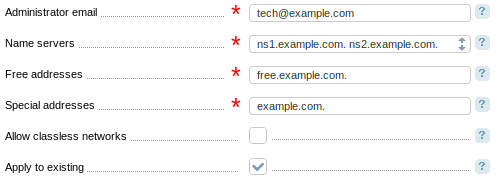IPmanager works with BIND (Berkeley Internet Name Domain) and PowerDNS which convert a DNS-name into an IP address and visa versa. The main benefit of BIND is that it is developed according to the official documentation which sets the rules for DNS-server management. According to the document, the DNS-server stores the information about domain names in files. PowerDNS is faster than BIND as it stores the information in a database. If you plan to use a large number of IP addresses, we recommend that you use PowerDNS.
IPmanager can be configured as a primary DNS-server. We recommend that you use at least two servers: a primary (master) and a secondary (slave) one. The primary DNS server stores the master copy of the domain zone file, which is maintained by the system administrator. The primary server gets information about the domain zone from its configuration files. The secondary server gets its domain zone settings from the primary server. You can use DNSmanager as a secondary server. Read more in Integration with DNSmanager.
DNS-server settings are added into the configuration file and are used when creating domain zones. For more information please refer to the article Reverse domain names.
DNS-server settings are unique for every "User" account in DNSmanager. To modify the settings, go to Settings → DNS settings.

Here you need to specify:
- Administrator email — email address of the DNS administrator. It is specified in the SOA records of the newly created domain zones. Learn more under Domain resource records;
- Name servers — enter the name(s) of the name servers that will handle the DNS records for this domain. They are specified in the NS-records;
- Free addresses — domain name given to IP addresses that become available again;
- Special addresses — domain name given to service IP addresses. For subdomains of service addresses it uses:
- subnet — subdomain for the network address and network addresses with /24;
- gw — subdomain for network gateway;
- broadcast — subdomain for the broadcast address;
- Allow classless networks — this option allows creating classless reverse DNS zones when creating IPv4 networks with the prefix lower than /24. When you disable this option for IPv4 networks with the prefix below /24, it will create reverse DNS zones with /24.
- Apply to existing — select the checkbox to apply new settings to all domain zones of the server.
 En
En
 Es
Es